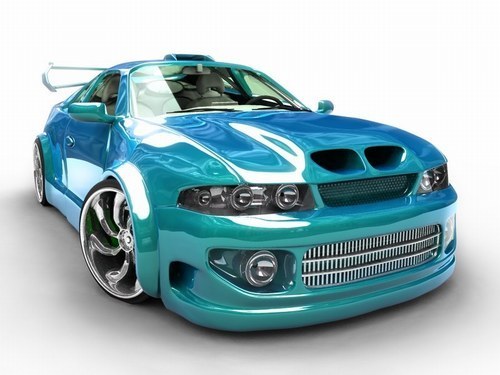
An all-new 2010 Honda Insight is expected to arrive in Honda showrooms by April. Honda hopes its 2010 Insight will re-establish the company as the leader in dedicated hybrid cars, and at a bargain price.
The original Honda Insight, built from 1999 through 2006, was the first gasoline-electric hybrid car available in the United States. It was almost experimental in look and character, a two-seater with limited mainstream appeal at a fairly hefty price.
The all-new 2010 Insight is a compact five-passenger, five-door sedan.
It's much closer to the mainstream than the original, and it's expected to sell for about $4,000 less than the class-leading Toyota Prius or Honda's own Civic Hybrid.
Like other current gas-electric hybrids, the new Insight will run on a combination of power from its four-cylinder gasoline engine and an electric motor fed by an on-board battery pack.
A key to overall fuel economy for all hybrid gas-electric cars is in what situations and how long they can run on just the electric motor, and how well the complex electronics manage transitions from gasoline power to electric or a combination of the two. Manufacturers are making substantial progress in these areas. These cars can offer fantastic fuel economy when they are able to run strictly on battery power in heavy, stop-and-go commuter traffic.
The Insight's 1.3-liter engine and electric motor combine for a total 98 horsepower, with a substantial 123 lb-ft of torque.
That should mean brisk acceleration in a car of Insight's weight (about 2700 pounds). Its electric motor, though, generates 13 horsepower by itself, which is substantially less than what the Toyota Prius motors can generate. That means the Insight will be able to run on just the motor only at lower speeds than Prius. Yet Honda says the Insight package has been optimized for efficiency at higher speeds. That could work better for drivers who spend more time on the open road than plodding in city traffic.
The current Prius, for example, is rated higher by the EPA for City mileage (48 mpg) than for Highway, and it's real-world highway mileage tends to drop substantially.
Honda projects the Insight's ratings at 40/43 mpg City/Highway. It could prove to be a more efficient choice for drivers who are moving more than they're stopped.
All Insights will come with something Honda calls the Ecological Drive Assist System, or Eco Assist. This system includes a driver-activated ECON mode that optimizes control of the continuously variable automatic transmission (CVT), engine and air conditioning to maximize fuel efficiency. It also features a dash display with real-time guidance intended to help drivers improve mileage. With a 10.6-gallon fuel tank, the Insight should deliver per-tank range beyond 400 miles.
The Insight's hybrid goodies are packed in a practical, if not particularly original looking, car: The Honda Insight looks a lot like the Toyota Prius.
Like the Prius, the Insight is shaped to accommodate five passengers and luggage with minimal mileage-robbing aerodynamic drag. That may be why, in profile, the Insight looks like the Prius, particularly through its roofline and tall, flat rear end. It front three-quarter view, it looks a lot like a Prius with a Honda-style grille and light treatment. In dimensions, the Insight is shorter than both the Civic Hybrid and the Prius, with about 11 cubic feet less passenger volume.
Still, the Insight's battery pack and electronic control unit are smaller than those in the Prius or Civic Hybrid, and they are packaged smartly below the floor with the gas tank.
As a result, there's good interior and cargo space. The rear seat offers excellent headroom and shoulder room; legroom is a bit tight, at least compared to the Civic Hybrid. There's a substantial 15.9 cubic feet of cargo space with all seats in use, and 31.5 cubic feet with the rear seat folded.
The Insight's dash design isn't exactly mainstream. It features a big, prominent wing over the gauge cluster, while switch placement is a bit new-age. The plastics and fabrics in the show car revealed at Detroit's North American International Auto Show in January seemed cheap, but they may improve by the time Insight hits production.
All Insights will come with a long list of standard features, including a 60/40 split-folding rear seat, automatic climate control, power windows, mirrors and door locks, a tilt-telescoping steering wheel, and AM/FM/single-CD with four speakers, 160 watts of output and an auxiliary audio jack. The upgrade Insight EX will add 15-inch alloy wheels, cruise control, six-speaker audio and electronic stability control. A voice-activated navigation system will be optional on the EX.
Safety features include dual-threshold front airbags, front passenger side-impact airbags with a passenger-side Occupant Position Detection System, head-protection curtains and anti-lock brakes.
Honda says improvements to its hybrid drive system (called Integrated Motor Assist) and new, more cost-efficient production methods will allow the Insight's price edge on the competition. The company also claims that this new level of affordability and Insight's dynamic character will attract more buyers under the age of 30. By comparison, the average age of Toyota Prius customers exceeds 50.
We'll see. Buyers are often older than marketing folks predict.
In any case, the Honda Insight looks to be a practical hybrid-powered five-passenger sedan.











No comments:
Post a Comment